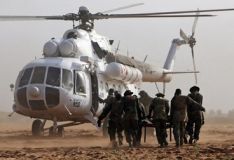Africa’s troubled Darfur mission
By Amber Henshaw
November 15, 2007 (KHARTOUM) — The African Union (AU) mission in Sudan has come under fire from all sides since it started its operation in Darfur in 2004.
 Its many critics, including the Darfur people forced to flee from their homes and now living in vast camps in Sudan’s western region, complain that the force has been ineffective – failing to protect them and achieving little in the three years it has been on the ground.
Its many critics, including the Darfur people forced to flee from their homes and now living in vast camps in Sudan’s western region, complain that the force has been ineffective – failing to protect them and achieving little in the three years it has been on the ground.
But sources close to the AU believe the mission never really stood a chance.
They say there were huge expectations about what it could achieve but they were never given the necessary resources.
“The African Union mission was set up to fail,” one military expert said.
“The bar was raised too high and they should have been given more support.”
WITHIN THE MANDATE
When it was first deployed, the AU mission was made up of just 60 military observers and its own protection force of just 300.
Its mandate was to observe and monitor a ceasefire agreement signed by Darfur’s rebel groups and the Sudanese government in May 2004 and to report violations.
But mission officers were not allowed to intervene and were only able to fire in self-defence if directly threatened.
One expert said their mandate had crept, driven by the deteriorating situation on the ground.
Mission spokesman Noureddine Mezni said: “One of our main problems has been the mandate. We could only monitor the ceasefire.”
Mr Mezni said the other major challenge they had faced over the last three years had been that of funding.
“You cannot have an efficient force when you are relying on voluntary contributions,” he said.
‘BEGGING BOWL’
A source close to the AU said that there had been immense problems with voluntary contributions.
He said that every time the mission mandate was extended they had to go round with their begging bowl.
Mr Mezni said they had never had enough equipment for the force:
“For example… we have one satellite phone between two or three people.”
The AU mission also struggled when it came to weapons.
Sources say they were outgunned from the beginning. The best weaponry they had was heavy machineguns and rocket-propelled grenades compared to rebels with mortars, multi-barrelled rocket launchers and anti-aircraft guns.
That was one of the problems in the eastern Darfur town of Haskanita where an AU base was attacked by scores of armed gunmen at the end of September.
They simply did not have the weapons to defend themselves, the camp was overrun and 10 soldiers were killed.
All these problems and setbacks have had a massive knock-on effect sapping the morale of peacekeepers.
It has also compelled the force – which until recently numbered 7,000 troops at its peak – to scale back its patrols and has diminished its capacity to protect civilians, aid workers and its own peacekeepers.
LESSONS LEARNT
Many of these same peacekeepers will stay on and become part of the AU-UN hybrid force Unamid, that will have 26,000 troops and policemen.
There is no doubt that the AU mission has not reached the expectations of the international community or Darfur people living in the camps.
Some say the failure may lie with the AU but not necessarily with the AU mission itself.
Critics accuse the AU of failing to ensure the mission had what it required – proper funding, personnel and equipment.
In defence of the mission, Noureddine Mezni said:
“Of course we had our shortcomings and our difficulties. But we did a lot, we made a difference. We are proud to have been the first to respond to the needs of the people in Darfur.
“UNAMID can learn lessons from the past. We hope they can benefit from the experience we had. We did not fail. We did our best.”
(BBC NEWS)
